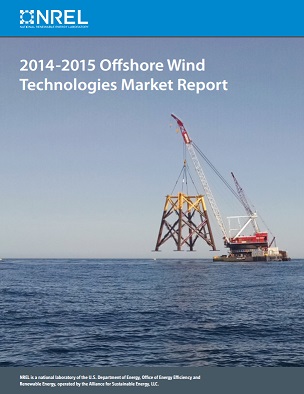 The Energy Department today released a new report showing strong progress for the U.S. offshore wind market—including the start of construction of the nation’s first commercial-scale offshore wind farm, one of 21 projects totaling 15,650 megawatts (MW) in the planning and development pipeline. Of these 21 U.S. projects, 13 projects totaling nearly 6,000 MW—enough to power 1.8 million homes—are in the more advanced stages of development, while 12 projects with more than 3,300 MW planned have announced a commercial operation date by 2020. With 80% of the nation’s electricity demand coming from coastal states, offshore wind could play a crucial role in meeting our energy needs.
The Energy Department today released a new report showing strong progress for the U.S. offshore wind market—including the start of construction of the nation’s first commercial-scale offshore wind farm, one of 21 projects totaling 15,650 megawatts (MW) in the planning and development pipeline. Of these 21 U.S. projects, 13 projects totaling nearly 6,000 MW—enough to power 1.8 million homes—are in the more advanced stages of development, while 12 projects with more than 3,300 MW planned have announced a commercial operation date by 2020. With 80% of the nation’s electricity demand coming from coastal states, offshore wind could play a crucial role in meeting our energy needs.
Announced at the American Wind Energy Association’s Offshore WINDPOWER Conference in Baltimore, Maryland, the 2014–2015 U.S. Offshore Wind Technologies Market Report was prepared for the Energy Department by the National Renewable Energy Laboratory and builds on the success and utility of the Energy Department’s annual Wind Technologies Market Report and Distributed Wind Market Report, which provide stakeholders with reliable and consistent data sources for their respective markets.
American developer Deepwater Wind—leveraging 25 years of European technical knowledge, as well as U.S. manufacturing and installation expertise—began construction of the Block Island Wind Farm off the coast of Rhode Island this spring. The 30-MW project is expected to be operational by fall 2016. In addition to Rhode Island, offshore wind projects in eight other states are also in the advanced stages of development.
The 2014-2015 U.S. Offshore Wind Technologies Market Report finds that offshore wind projects continue to trend farther from shore and into increasingly deeper waters. Continuing to increase in size, the average offshore wind turbine installed in 2014 had a 377-foot-diameter rotor on a 279-foot-tall tower. The average capacity of offshore wind turbines installed in 2014 was 3.4 MW (compared with 1.9 MW for land-based turbines). Last year also marked the first deployment of an 8-MW prototype, and a number of turbines rated between 6 MW and 8 MW have been ordered for pending projects. By siting projects farther from shore where they can access stronger, more consistent winds, combined with technology improvements and larger turbines, developers have increased their turbines’ capacity factors, meaning each wind turbine can generate more energy.
The study’s authors expect this year to become a record year for global offshore wind deployments, with 3,996 MW of capacity on track to begin operations. In the first half of 2015, the industry commissioned 1,190 MW of this capacity, bringing the total current installed capacity to 8,990 MW worldwide.
Read the full report and download the underlying data.
The Energy Department’s Office of Energy Efficiency and Renewable Energy accelerates development and deployment of energy efficiency and renewable energy technologies and market-based solutions that strengthen U.S. energy security, environmental quality and economic vitality. Learn more about the Department’s efforts to research, test, develop and deploy innovative offshore wind energy technologies. Watch our Energy 101 video on Wind Turbines to learn how these engineering marvels capture renewable energy from the wind.
Filed Under: Construction, News, Offshore wind




